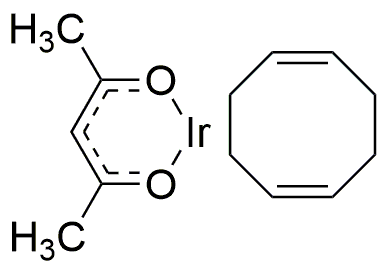(Acetylacetonato)(1,5-cyclooctadiene)iridium(I) is widely utilized in research focused on
- Catalysis: This compound serves as a catalyst in various organic reactions, enhancing reaction rates and selectivity. It is particularly effective in hydrogenation processes, making it valuable in the production of fine chemicals.
- Materials Science: Its unique properties allow it to be used in the development of advanced materials, such as conductive polymers and nanocomposites, which are essential in electronics and energy storage applications.
- Pharmaceuticals: The compound plays a role in drug synthesis, particularly in the creation of complex organic molecules. Its efficiency can lead to reduced production costs and improved yields in pharmaceutical manufacturing.
- Environmental Chemistry: It is utilized in the degradation of pollutants, aiding in the development of green chemistry practices. This application is crucial for industries aiming to reduce their environmental footprint.
- Research and Development: As a versatile reagent, it is frequently used in academic and industrial research settings to explore new chemical pathways and reactions, fostering innovation in synthetic chemistry.
General Information
Properties
Safety and Regulations
Applications
(Acetylacetonato)(1,5-cyclooctadiene)iridium(I) is widely utilized in research focused on
- Catalysis: This compound serves as a catalyst in various organic reactions, enhancing reaction rates and selectivity. It is particularly effective in hydrogenation processes, making it valuable in the production of fine chemicals.
- Materials Science: Its unique properties allow it to be used in the development of advanced materials, such as conductive polymers and nanocomposites, which are essential in electronics and energy storage applications.
- Pharmaceuticals: The compound plays a role in drug synthesis, particularly in the creation of complex organic molecules. Its efficiency can lead to reduced production costs and improved yields in pharmaceutical manufacturing.
- Environmental Chemistry: It is utilized in the degradation of pollutants, aiding in the development of green chemistry practices. This application is crucial for industries aiming to reduce their environmental footprint.
- Research and Development: As a versatile reagent, it is frequently used in academic and industrial research settings to explore new chemical pathways and reactions, fostering innovation in synthetic chemistry.
Documents
Safety Data Sheets (SDS)
The SDS provides comprehensive safety information on handling, storage, and disposal of the product.
Product Specification (PS)
The PS provides a comprehensive breakdown of the product’s properties, including chemical composition, physical state, purity, and storage requirements. It also details acceptable quality ranges and the product's intended applications.
Certificates of Analysis (COA)
Search for Certificates of Analysis (COA) by entering the products Lot Number. Lot and Batch Numbers can be found on a product’s label following the words ‘Lot’ or ‘Batch’.
*Catalog Number
*Lot Number
Certificates Of Origin (COO)
This COO confirms the country where the product was manufactured, and also details the materials and components used in it and whether it is derived from natural, synthetic, or other specific sources. This certificate may be required for customs, trade, and regulatory compliance.
*Catalog Number
*Lot Number
Safety Data Sheets (SDS)
The SDS provides comprehensive safety information on handling, storage, and disposal of the product.
DownloadProduct Specification (PS)
The PS provides a comprehensive breakdown of the product’s properties, including chemical composition, physical state, purity, and storage requirements. It also details acceptable quality ranges and the product's intended applications.
DownloadCertificates of Analysis (COA)
Search for Certificates of Analysis (COA) by entering the products Lot Number. Lot and Batch Numbers can be found on a product’s label following the words ‘Lot’ or ‘Batch’.
*Catalog Number
*Lot Number
Certificates Of Origin (COO)
This COO confirms the country where the product was manufactured, and also details the materials and components used in it and whether it is derived from natural, synthetic, or other specific sources. This certificate may be required for customs, trade, and regulatory compliance.


